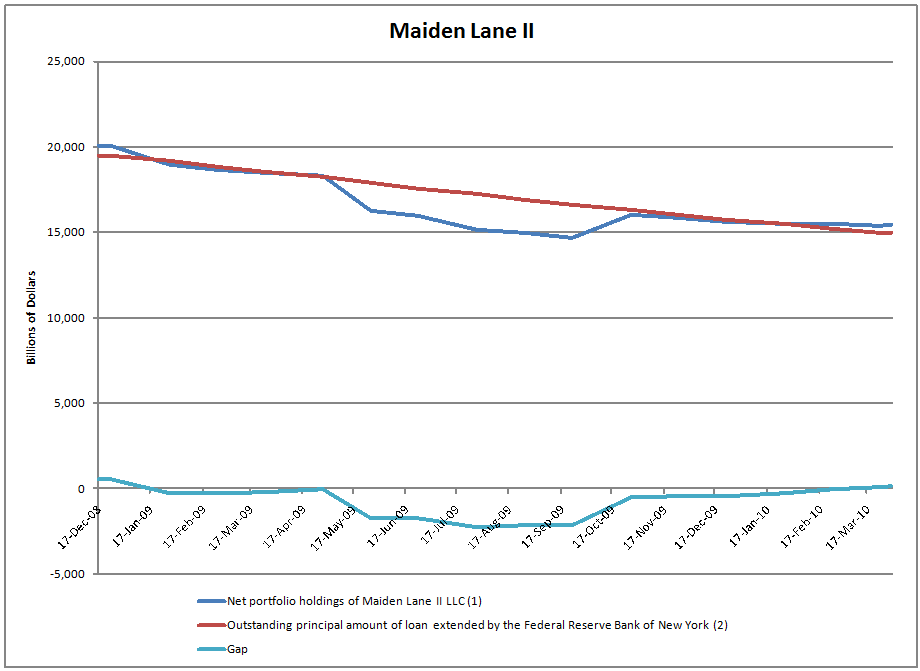I hate working in an information vacuum.? Look, I lack the advanced analytics of major Wall Street firms.? A Bloomberg terminal is powerful, but not as good as the major investment banks, or third party specialists.
My friend jck gave me constructive criticism regarding my post on Maiden Lane III.? I am still waiting for the 2009 audit report for Maiden Lane III.? It should be published soon.? The 2008 report said that there were no gains or losses.
jck said that I should look at the decrease in book value in liabilities over time — that would measure the success of Maiden Lane III over time.? But any payment on the liabilities should stem from a diminution of the assets.? Even though the assets are held at fair value, and the liabilities at book value, this would still remain true.? Thus the gap between assets at fair value and liabilities at book value have significance.? So here it is for Maiden Lane III:

With ML III there was an investment of $5 billion of equity, there is still a loss against that yet, though not much.
But there is a similar graph for Maiden Lane II:

There is a rhythm to this because assets are revalued in the first month of the quarter, whereas liabilities are fixed, at least subject to paydowns and draws.? I would not be surprised to see a further improvement in the gap by the end of April, even as credit metrics continue to decline.
The Maiden Lane II Portfolio
Aside from two privately placed interest only securities, the rest of Maiden Lane II could be modeled.? Here are the credit metrics:
| Rating | Principal $K | Percentage |
| AAA | 1,719,167 |
5.0% |
| AA | 2,173,090 |
6.3% |
| A | 2,166,569 |
6.3% |
| BBB | 1,211,229 |
3.5% |
| BB | 2,648,188 |
7.7% |
| B | 4,955,596 |
14.4% |
| CCC | 16,362,857 |
47.6% |
| CC | 2,456,082 |
7.1% |
| C | 687,387 |
2.0% |
| Total | 34,380,166 |
The average credit rating is B-, with a downward tendency.? 56.7% of the portfolio is rated CCC and below, and 71.2% of the portfolio is rated B and below.? But what types of collateral are in the portfolio?
| Alt-A | 4,289,185 |
12.4% |
| HELOC | 1,012,497 |
2.9% |
| Home Equity | 8,644,853 |
25.0% |
| Subprime RMBS | 13,581,921 |
39.3% |
| Fixed WL | 500,599 |
1.4% |
| Floating WL | 6,519,656 |
18.9% |
| Total | 34,548,712 |
All of it is housing related.? None of it is agency quality.
What sort of origination vintages does the portfolio have?
| Issue Year | Principal $K | Percentage |
| 2000 | 503 | 0.0% |
| 2001 | 1,657 | 0.0% |
| 2002 | 690 | 0.0% |
| 2003 | 112,273 | 0.3% |
| 2004 | 747,871 | 2.2% |
| 2005 | 5,630,124 | 16.3% |
| 2006 | 17,635,093 | 51.0% |
| 2007 | 10,251,954 | 29.7% |
| 2009 | 168,547 | 0.5% |
| Total | 34,548,712 |
The average vintage is mid-2006, which is lousy for any debt portfolio on residential real estate in the US.? I would expect bad performance from a portfolio with these characteristics.
Compared to ML III, ML II has better collateral, but worse vintage years.? Both are messes.? I am not saying that the Fed will necessarily lose money on either one, but I question the valuations on the assets.? If Blackrock is doing the valuations, maybe I should be quiet — who has more knowledge than they do?
All the same, I still question the ability of two Fed vehicles to extract liquidity out of illiquidity, and on favorable terms.

“Information vacuum” is the right way to put it.
As long as we don’t know exactly how the loan is being repaid either positive carry, sales, pay-downs, etc… it’s hard to take a view.
Good blog.
You are researching well.
…(I’d be pleased if you exchange reciprocal link with me.)